alan little’s weblog archive for january 2005
yoga hypocrite
28th January 2005 permanent link
Time spent this week writing a long post about how people who find yoga asanas difficult should just shut up and practice more: several hours.
Time spent this week practicing difficult yoga asanas: considerably less. Almost none, in fact.
Reason for this: last week of a high pressure project at work, combined with all three members of my household ill at the same time, with three different illnesses.
What I hope won’t happen next: we all get all three illnesses one after another.
yoga curmudgeon
27th January 2005 permanent link
In which Alan sort-of-reviews a yoga DVD he hasn’t actually seen.
People whose opinions I respect seem to be very enthusiastic about Paul Grilley’s Anatomy for Yoga DVD – “the best DVD on yoga, period” (Dan McGuire) – and I’ve been checking it out with a view to deciding whether I need/want to buy it in addition to David Coulter’s marvellous book Anatomy of Hatha Yoga (a full review of which I will probably never get round to writing).
I’ve noticed a disturbing trend in how people seem to be taking Paul Grilley’s message, though. These comments are about that and not about what he actually says on the DVD which, as I said, I haven’t seen.
Apparently Grilley’s central theme is that everybody has a different shape and different physical limits, and so there cannot be a single definitive right shape or end point that is the same for everybody in any yoga asana. I completely agree with this.
One point Grilley makes that seems to catch people’s attention is that there are fundamental skeletal limits to how far each individual can go in particular postures now matter how long and how diligently they practice – the proportion of their limbs and the shape of the joint surfaces of their bones. Sooner or later, if you could overcome all other physical limitations in a posture you would still reach a point where you have bone pressing against bone and that’s it. Finito. Impossible to go any further and dangerous to try. And this point is different for everybody, because we all have different shaped bones.
I don't doubt that either – but people seem to be latching on to it as an explanation (excuse) for why they have great difficulty with routine, standard postures …
you doubt you will ever be able to get your knees even an inch closer to the floor. … That may well be true--but it probably has nothing to do with your yoga practice. Instead, it's simply the way your bones are structured. And yoga will never change that.
This is the main message Paul delivers in his superb DVD on yoga anatomy
Tim Noworyta
… and that, I think, is bullshit. Lotus, for example, isn’t that difficult. Most Indians I have seen try it can do it quite easily. And since Indians, especially upper caste Indians, are genetically pretty similar to Europeans, how likely is it that Europeans generally have different shaped hip joints that made it harder for them to sit in lotus and similar postures? Not very. They just sit on chairs. There may well be people whose hip socket shape makes lotus impossible, but I think they’re probably a tiny minority.
if you're trying to choose between two theories and one gives you an excuse for being lazy, the other one is probably right.
Paul Graham
Terry Slade (Terry is one of the founding fathers of ashtanga yoga on the web, and a thoroughly sound guy from what I can tell of the e-contact I’ve had with him over the years) is a huge Grilley fan, but he was probably right first time:
I have always thought that the huge amount of deep chronic tension that I have in my body is what makes it important for me to be careful to find the right way to practice yoga
I'm all for yoga students having a sound grasp of anatomy and not hurting themselves. I’m not for encouraging beginners (and anybody, e.g. me, with less than about ten years of diligent regular practice is a beginner) to think their limitations are probably inherent to their skeletal structure and it’s not worth bothering to even try.
Here are a couple of questions to ask yourself about asanas (postures) you “can’t do”:
Have I tried it at least a thousand times? Pattabhi Jois says you need to have done an asana a thousand times before you really know it. (If you go to class a couple of times a week, and don’t practice otherwise, and attempt your problem asana in all the classes you go to – well, there’s that “ten years” figure again)
Can a teacher get me into it? It is normal in ashtanga vinyasa yoga, the style I personally practice, for teachers to assist or “adjust” students in asanas the student is currently learning. I believe this is less common in other yoga styles, and some people think it is bad because it encourages students to feel dependent on the teacher. I understand that point of view but don’t agree with it. The best teachers, such as Pattabhi Jois and his grandson Sharath, can adjust students way beyond the student’s perception of what is possible. Which can teach you several things: what the position should feel like, so you know what you’re working towards; that limits you might have thought were physical were actually in your head after all; not to get too comfortable with your perceived limits.
The hardest position in the ashtanga vinyasa yoga primary series, for most western students, is called Marichyasana D. It involves putting one leg into half lotus position then twisting round, wrapping an arm round the opposite knee and clasping your hands behind your back. Pardon? Like this (only better):
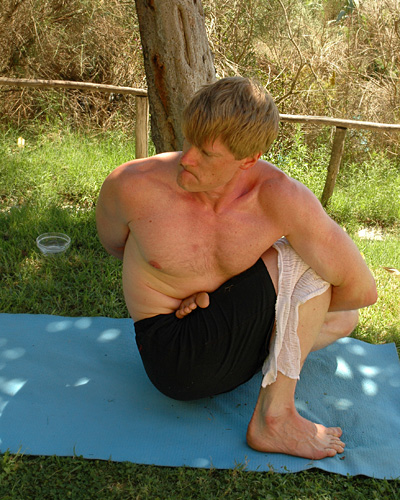
When I first saw it, I thought it just looked ridiculous. My attempt at putting my foot onto my opposite leg to get into half lotus ended somewhere just above my knee. I could have just thought “ok, I know I have a bad knee, this is clearly impossible for me”. But after a while I started to see progress, and people around me in class learning it, so I thought well ok, one day. After trying it for about four years I was getting close: then I went to Mysore, where Sharath put me into the position a few days after I arrived. Within a couple of weeks of thus being shown that I could do it, on my “good” side I could do it myself.
The side where my injured knee is in lotus is proving more difficult: three years after Sharath could get me into the position, I can still count on my fingers the number of times I’ve managed it on my own. For one of those three years, though, I was busy starting to learn something far more important, namely how to be somebody’s dad, and hardly had time to practice yoga at all; then when I began practicing again it took another half a year to get back to where I was before I started making progress again. Nevertheless, my teacher and I both agree that it feels like it could be Real Soon Now.
The point being: something that initially looks and feels impossible may indeed actually be impossible because you have the wrong shaped bones – or it may just need five to ten years of diligent effort. And if it matters to you, then you shouldn’t assume one until you’ve tried the other.
related entries: Yoga
jack’s mountain
27th January 2005 permanent link
The north east ridge of Jack’s Mountain overlooks the hollow of the north face, whose steep headwall attracts adventurous winter sports enthusiasts. The ridge itself can be icy and difficult; the last time we were there we had to rescue a fallen climber. The north west flank is easier angled and more popular with the masses. The south and east slopes are thickly wooded; there is a path through the trees to the summit from the south east.
Jack’s Mountain is about twenty feet high, and situated in the playing field at the end of our street. It’s the most popular sledging slope in the area for parents with small children; the man from the city council comes in November and ties hay bales to the solitary tree at the bottom, then we wait for the snow to come.
When Jack’s dad’s foot slips, pulling Jack’s sledge up the hill, does Jack’s dad remember, briefly, the crunch of crampons on ice the year the northern lights came as far south as Glencoe? Does he find the sledge gathering momentum faintly reminiscent of how the snowboard felt, floating, the day after the storm with John, dropping off the end of the Hintertux glacier into miles of fresh untracked powder? (John has a baby daughter now too) He does.
But these things do not confuse him.
He knows Michael Smith is right and happiness, if it is anywhere, is Here and Now and not on some big hill far away in Scotland or Austria. Nothing ever was or ever will better than letting Jack ride on his own if the snow is fresh and soft, and running next to him to hear him laugh; or riding with him when it’s icy and we have sneaked out for an illicit boys’ night run on mum’s yoga class evening, and one of us is slightly afraid of the rush in the dark but it isn’t Jack.
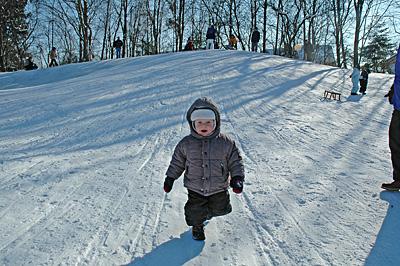
lotus without tears
22nd January 2005 permanent link
Michael Smith is considering my advice about whether special meditation chairs are a good idea:
Of course the correct answer, long term, is to develop the ability to sit comfortably for long periods in lotus. Which, however, starts with developing the ability to sit very uncomfortably for very short periods in lotus. And takes years.
Padmasana, lotus position, the position in which the Buddha is normally shown sitting, is the iconic yoga position. There’s a good reason for that: once you can do it comfortably it is the most stable, supported sitting position for breathing exercises or meditation. (It has proven medical benefits too). Unfortunately a lot of western yoga students pursue it not for that reason, but because it’s seen as an “advanced”, cool-looking physical feat. In Indian eyes it isn’t at all: most Indians, who grew up sitting on the floor, can do it quite easily even if they aren’t otherwise particularly fit or flexible. But for many westerners who grow up sitting on chairs and consequently have very little mobility in their hips, it is difficult. It can take years to learn and a lot of people hurt their knees trying.
Lotus seemed frighteningly far away to me when I started yoga. I had even tighter hips than most western men – I had been rock climbing for years, and friend of mine who has taught yoga to a lot of climbers says they tend to have very tight hip flexor muscles because of all the high-stepping manoeuvres that climbing involves. (If I had known that years earlier it would have helped me a lot). In addition, my whole right side from (at least) the ankle to the hip was much tighter than the left because I carried a serious knee injury for years. Seven years on, I can get into lotus quite comfortably once I’m warmed up. I rarely sit in it for longer than about five minutes, but at this stage that’s more about monkey mind than physical discomfort. I actually find easier yoga sitting positions, such as a fairly loose half-lotus, more comfortable now than sitting on chairs.
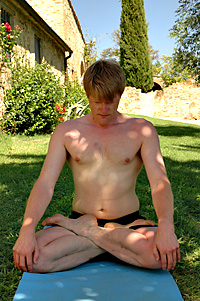
padmasana
If I can learn it, starting where I was seven years ago, then most people can. Along the way, though, I had two years of knee pain caused by going about it the wrong way, that should have been avoidable.
(I have one of those wedge-shaped meditation cushions that I bought during the knee pain period because I thought it might help. And maybe it did at the time, but I never use it any more. I feel more comfortable and stable sitting on the floor – and comfort and stability are the desiderata for all correct yoga positions according to Patanjali: shtiram sukham asanam)
There is excellent advice on how to learn lotus safely in this article in Yoga Journal by Roger Cole. This has the clearest explanation I’ve seen of the most common lotus-related knee problem that lots of western students have – the cause and how to avoid it – information that could have saved me lots of trial and error, some of it painful, if I had known it sooner. Short version: it’s all about outward rotation of the thigh in the hip socket. People who try to get into lotus when their hips aren’t flexible enough have to pull sideways on the foot to get it up onto the opposite thigh. The knee is not designed to bend sideways; trying to get it to do so puts excessive pressure on the cartilage on the inner edge of the joint and is painful and dangerous.
A couple of other bits of safe-lotus advice that I’ve picked up over the years: British yoga teacher Godfrey Devereux showed me how to fully bend the leg, with the heel firmly against the upper thigh, while the thigh is still in a comfortable position. Then you can move the whole folded leg as a unit, pivoting at the hip, without any movement in the knee. Also important to keep the foot flexed. This technique ended my two year spell of knee problems and got me into lotus without pain for the first time.
Corrolary that I learned myself: even though the main motion should come from the thigh and not from pulling on the foot, until you are very flexible you will still need to use your hands to guide and assist the foot up onto the opposite thigh. Do not pull on the foot. If you hold the foot it’s very likely that you will at some point pull too hard on it in the wrong direction, thus bending the knee sideways again. Much better instead to hold the shin just above the ankle – that way you can guide the heel in horizontally towards the hip/navel with much less danger of pulling upwards.
Ahimsa. Ahimsa is the fundamental yoga principle of not doing unnecessary harm. As many yoga students discover the hard way, that includes not harming yourself in pursuit of the outward appearance of an “advanced” yoga practice. Of all Indian religious groups, Jains place the most emphasis on ahimsa – this thousand year old Jain yogi has chosen not to force himself into padmasana and is using an easier meditation position instead.
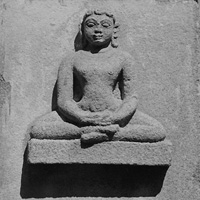
Jain yogi, Sravanabelagola
Disclaimer: taking advice about how to do difficult yoga asanas from random strangers on the internet may not be the wisest thing you could possibly do.
Michael Blowhard is right: “Patience and hard work … play discouragingly big roles”.
Lotus Without Tears Part 2, Part 3
related entries: Yoga
coffee yoga?
18th January 2005 permanent link
And what, excessively puritanical western yogis might ask, is Alan doing recommending coffee? Even if it is in a good cause? To such people I say, ha!

Pattabhi Jois personally recommended coffee to a friend of mine as a solution to the difficulty she was having making it to class on time at 4:30 in the mornng. Mysore is a couple of hours drive from India’s finest coffee growing area, and a lot of yoga students take full advantage of this fact. My own coffee habit is – well, perhaps more than it should be – but still at one of my regular cafe haunts I had to beg them to make a special reduced-strength version of the rocket fuel they normally served.
related entries: Yoga
supporting sumatra
16th January 2005 permanent link
When I donated money for tsunami relief, I noticed that Ärtzte Ohne Grenzen, the German branch of Medecins Sans Frontieres, have closed their Tsunami appeal fund because they say they already have enough money for what they are doing. This strikes me as a sign of a deeply honest organisation.
Meanwhile, if I have any readers in Munich they might like to note that the San Francisco Coffee Company is donating €4 to tsunami relief for every kilo of Indonesian coffee they sell. So I’ve been laying in stocks of their Sumatra coffee, which is my favourite anyway.
My coffee book says about Sumatran coffees:
… noted for their richness, full body, and an acidity that, though pronounced, is deep-toned and gentle. They are perfect for those who want a coffee heavy enough to carry its flavor through milk. Indonesian coffees are leisurely. There is something warm and relective about them. … Many consider the Mandheling and Ankola coffees of Sumatra to be the world’s finest. … Mandheling is probably the most full-bodied coffee in the world. … The flavor, like the body, is rich, smooth and full.
SFCC’s Sumatra isn’t Mandheling, but it’s still pretty fine stuff.
I’m well aware that coffee growing regions are unlikely to be the most directly affected. Anything that caused a tsunami big enough to take out high altitude coffee plantations would certainly end civilization, and quite possibly all higher forms of life on earth. But coffee is the only world famous Sumatran export that I’m aware of; and for long term reconstruction it’s just as important to support Sumatran businesses as to donate to relief organisations.
a walk in the park
16th January 2005 permanent link
Sunday Photography Vignette: I just got home from a Sunday afternoon family walk in the park, with a 512 MB flash card crammed to bursting with 90 pictures. This is exactly the reason why I got my Nikon D70 – I would never have taken three rolls of film with me just for a Sunday afternoon family walk (I’m sure some people would, and good luck to them, but I’m talking about me here) and, other things being equal, the more pictures you take the better your pictures will become. Taking pictures is far more important than having any amount of expensive exotic lenses. Practice, practice, practice.
There is a great, classic photo to be taken in Munich’s Westpark (just as there is everywhere). This isn’t it, but I might take it one day if I practice enough.
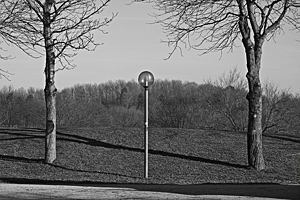
related entries: Photography
your camera does not matter
16th January 2005 permanent link
Instapundit introduces us to South Knox Bubba, who introduces us to the bizarre concept of a “basic DLSLR kit”’ costing a shade under ten thousand dollars.
Folks, try not to worry too much if you don’t have a ten grand starter budget. You can win photojournalist of the year with a $500 digicam. Alternatively, Ken Rockwell has some sensible advice about starter lenses for DSLR photography. Dante Stella also has strong views on what lenses most photographers need/can use effectively (although I disagree with him about 180mm telephotos)
Let’s take a look at Bubba’s ideas anyway. I have no interest in Nikon-vs-Canon religous wars. (I personally shoot Nikon. I’ve been very happy with the Nikon cameras and lenses I’ve used; I’m sure Canon make very good cameras and lenses too)
Canon kit:
20D Body: $1400
24-70mm F2.8: $1095
70-200mm F2.8 IS: $1600
400mm F4 DO IS: $5300
100mm F2.8 Macro: $450
Total: $9845
Nikon Kit:
D70 Body: $900
17-55mm DX F2.8 $1350
70-200mm F2.8 VR: $1600
200-400mm F4 VR: $5300
105mm F2.8 Macro: $580
Total: $9730
In the Canon kit he hasn't got a wide angle lens (24mm isn't wide on a 20D) – he realises this. But if you’re actually interested in taking pictures rather than dick-waving, a wide angle lens costing a few hundred bucks is going to be useful far more of the time than a 400mm, $5,000 mega-wonder-telephoto.
He hasn't got a really good portrait lens in either kit. The macro lenses could serve in a pinch, but on these cameras they’re really too long, and at f2.8 they’re not really fast enough for available light indoors either. For both Canon and Nikon a 50mm f1.8 costs a hundred bucks or so and makes a lovely indoor portrait lens on a small-sensor DSLR.

No batteries, no flash cards, no flash. With either of these cameras I would want at least two batteries and three or four one gigabyte cards. If I were laying out this kind of cash I’d want a proper flash gun too. The built-in flash on the D70 is ok for daylight fill flash, but for non-available light indoor photography (an abomination, but necessary sometimes) you really need more power and the ability to do bounced and/or diffused indirect light. Plus you’re quickly going to find you want powerful flash and a beamer a lot of the time with your $5k giant telephoto lens.
I really question the usefulness of those $5k giant telephotos. If I were a professional sports or wildlife photographer, or rich (“professional sports or wildlife photographer” and “rich” being pretty much mutually exclusive), I would buy the Nikkor 200-400mm tomorrow. But I’m not, and while I’m sure a lens like that would be great fun to play with I don’t think it would actually help to improve my photography.
Bubba specifically says he’s looked at the specs of high end pro SLRs and decided he doesn’t need them. Fair enough. If I had that kind of money to spend, I’d sooner spend half of it on a Nikon D2x (due out in February) or a used Canon 1Ds (seem to be going for around $4k on ebay) than on some esoteric wonder lens.
Here’s what I’d do with ten thousand dollars to spend on a Nikon DSLR kit, following Bubba’s rule of buying new from B&H:
| D2x body: | $4995 | Due out in February, this seems to be the expected price |
| 50mm f1.8: | $100 | budget portrait lens. Alternatively the 105mm f2 ($920) or the 85mm f1.4 ($1000) – both reputedly absolutely lovely lenses, but a bit long for portrait use on a small frame DSLR. |
| 70-200mm F2.8 VR: | $1600 | I already have the lovely 180mm f2.8. If I were buying again, I’d get the zoom for more versatility |
| 17-55mm DX F2.8: | $1350 | I really want something a little bit wider than the 18-70 that comes with the D70. This or the 12-24 ($940) |
| SB800 flash with SC29 cable: | $395 | |
| 300mm f4: | $1100 | The teleconverter, the 300 f4 and the 80-400 are all good options costing well under $5k if I decide I really need something longer than the 70-200 (already equivalent to a 300mm f.28 in 35mm). I’d try the teleconverter first. |
| 80-400mm VR: | $1430 | |
| TC17e teleconverter: | $420 |
Total: $8860
I don’t know the Canon range so well so I won’t comment in detail. I’d go for a used 1Ds for around $4k, swapping that for the 400mm telephoto. On this body 24mm is wide enough, but I’d definitely want the 24mm Tilt-Shift ($1000) for landscape photography. If I still had any money left over I’d get the 100-400 IS zoom ($1410).
And what would I get on an absolutely unlimited budget? There’s definitely Leica M7 in there somewhere, plus a Phase One P25 and something Zeiss-y to stick on the front of it. I could make Bubba’s $10k look like small change.
Update: reading further, I see that Bubba is into bird photography. In which case yes, he does need those big long lenses. I retract the bit about “dick waving”. (I was wondering if he might be into sports, in which case neither the D70 nor the 20D is fast enough for serious use). He says he’s quite happy with 6 or 8 megapixels resolution, and “To me, the lenses are the biggest investment. New bodies will come along all the time.” Which is true. For me, resolution, low light ability and a fast(er) camera are the things worth spending money on for the sort of photography I find interesting; Bubba has clearly thought his priorities through and decided that for him telephoto reach is very important. Fair enough.
related entries: Photography
photography quotes
13th January 2005 permanent link
the most rewarding part of photography is the picture-taking, rather than the end results. … loads of dusty photo albums – or from now on chunks of memory on my hard drive – are a small price to pay for the chance to really look at the world now and then.
Mick Hartley
Hallelujah, brother!
related entries: Photography
note to self …
12th January 2005 permanent link
… do something about system for sending Notes to Self.
Venkatesh in Bangalore found my notes on photography in southern India “interesting and fairly accurate without any bias like other foreign tourists have”, and was kind enough to send me a mail saying so. He did this in November but I only noticed and thanked him for it yesterday, because his mail started with the word “notes” and therefore got filed by my mail rules in my “Notes to Self” folder. Which I remember to look in – at least once every six weeks, it would seem.
I could easily fix the mail rule and use some kind of special tag in the mails I send myself instead of a common English word, but that really isn’t the point. The point is that sending myself email as part of my system for Being Organised clearly isn’t working all that well. Ditto with my system for draft weblog entries, which exist with various degrees of duplication and overlap in at least three places: in a folder on my laptop (supposedly the master); on the USB drive I keep bits and pieces on when I don’t have my laptop with me; and in the mail folder (see above) where I file things that I send myself from places where I don’t have either the laptop or the USB drive with me.
Now it’s good to have a system with multiple levels of fallback and redundancy – but only if you’re reasonably coordinated about checking all the places where you know you keep things and, ideally, consolidating them into one place. Weblog drafts not really all that important? Granted, but this is also not untypical of how I try to “organise” myself to do other things. Attempting to come up with Systems doesn’t help much when what you need is a radical Habits Transplant. (There’s a lesson in there for software development too)
Constructive suggestions welcomed.
tsunami
11th January 2005 permanent link
I haven’t said anything about the tsunami because I don’t have any special insight to add to what lots of other people have already said. Amit Varma has.
I have visited the fishermen’s district of Trivandrum, the state capital of Kerala. It’s obviously and by far the poorest part of the city and it’s on a sand-spit maybe a couple of metres above sea level. A lot of people live there. Fortunately for them Trivandrum is on the west coast, otherwise there would have been nothing left. I assume fishing villages in Tamil Nadu are (were) much the same.

Fishing boats, Trivandrum. People’s houses are right behind the boats, not significantly higher above water level.
whither python?
11th January 2005 permanent link
Iwan van der Kleyn has opinions similar to mine on python: lovely language, shame about the chaotic/absent infrastructure:
I’m not a language guru nor a framework wizard, but a mere mortal who designs and writes programs for end-users. For that task I need: a better standard ide, an integrated db interface with a proper set of db drivers (!!), a better debugger, a standard widget/windows toolkit, something akin to a standard for web programming, better documentation, a standard lib which is better organized, a formalized set of protocols and patterns for program construction. And an interpreter which is fast enough to avoid using C or Pyrex in most obvious cases.
Of course one valid answer to both Iwan and me would be “it’s all open source, pick where you want to start helping”. To which, however, Paul Rubin (further down in the same discussion) replies
I’m happy to use Python, as it is, for various kinds of noncritical and throwaway tasks. For critical projects I’m looking for tools that work (e.g. Linux, Apache, GCC), not “it’s open source, go fix it”.
Alex Martelli points out that the defined standard language isn’t where such things belong:
what YOU think should happen regarding the infrastructure, and what the people who donate their time to actually make things happen want, may be totally at odds. For example, you appear to keenly want one standard IDE to be blessed and receive all attention, one standard web framework ditto, and so on, and so forth; most core developers, on the other hand, appear to be very modestly inclined to spend their time and energy in that direction, so that only a rather minor fraction of the python-dev effort is channeled that way. Innovative efforts are best kept OUT of the core Python standard, many of us believe, as long as their innovative fervor continues: once something does get into the standard Python library &c, it won’t and shouldn’t develop very fast, nor at all freely, due to the tiranny of backwards compatibility, cross platform support, and the huge increase in maintenance/support efforts that comes when something suddenly becomes much more widespread and widely used than it previously used to be.
Fair enough. I’m all for emergent versus dictated standards. Nobody decreed that Apache should become the world’s standard http server, it became it by being better, and better supported, than the others. But now it’s there and and the rest of us have one less problem to worry about - you want to serve http? Install a current build of Apache and move on to worrying about other, more interesting things. But in web applications, for example, python doesn’t appear to have anything resembling an emergent standard either (unless you want to enter the strange world of Zope). And really, is web application infrastructure such an interesting area for “innovation”? Personally I’d sooner have a mature, supported, widely understood web application framework that I can just use without having to think much about it, and get on with using it to build applications that actually do something interesting.
As Iwan points out elsewhere, the issue with web development in python isn’t that there are no frameworks but that there are too many in various different states of baroque frighteningness (Zope/Plone) or not-quite-finished undocumentedness (the others):
The problem with Python is not that it doesn’t have any web-based frameworks comparable to Rails, the issue is it has too many of them and often much more heavy weight and able than Rails. Zope, Twisted, Webware, Peak are all heavyduty monsters while there are loads (dozens) of solutions implementing parts of the Rail stack much better then Rails does (SQLObject and ZTP are superb examples). But which one to choose? That remains the question.
A couple of related links: A M Kuchling thinks python the language is fine, and the development focus needs to switch to updating and tidying up the standard libraries. Good discussion in the comments section, including the inevitable and not incorrect “well then, pick a standard library, update it and tidy it up!”. And Kevin Dangoor explains why he chose python for a project he’s working on, and some alternatives he considered.
Update: Greg Wilson is “wondering why, ten years on, the Python community still doesn't realize how damaging it is to offer half a dozen half-baked alternatives instead of a single clear answer. Freedom of the press, different systems are best for different things, blah blah blah... I don't buy it any more. I just want the authors of Quixote, Twisted, WebWare, and the rest to sit down, hammer out their differences, and come up with something that's as technically and socially compelling as RubyOnRails”
related entries: Programming
jack in russia
8th January 2005 permanent link
Pictures of my son Jack visiting his grandma in Russia. Intended mainly for his other grandparents, but anybody else who feels like it is welcome to have a look too.
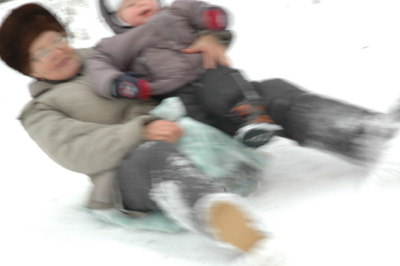
related entries: Photography
save fuel – fly
7th January 2005 permanent link
Interesting fact rescued in the nick of time from a Lufthansa in-flight magazine that was being systematically destroyed by a bored toddler: the average fuel consumption of Lufthansa’s passenger fleet is 3.7 litres per hundred passenger-kilometres.
That’s 63 passenger-miles per US gallon, or 76 per British gallon. Not bad – comparable to a normal car with two or three people in it, depending on how you define “normal car”. I’m defining it as anything in which I might actually consider driving several hundred miles on the autobahn, i.e. not one of those little Volkswagen Polo diesels that are allegedly capable of 3 litres per hundred kilometres. In any case, it’s quite a bit better than I would have guessed.
yoga tourists?
7th January 2005 permanent link
The minimum enrolment period at Pattabhi Jois’s yoga school in Mysore is a month. At times the school is so busy that the amount you can expect to learn in a month is really pretty minimal. Russell says “The first month they ignore you. The second month they take you apart. The third month they put you back together.” I don’t know about “ignore”. “Observe”, perhaps. I’ve also heard another senior teacher say he doesn’t feel he knows a student well enough to work seriously with them until he’s seen them every day for at least a month. And I should point out that when I was in Mysore Sharath, Pattabhi Jois’s grandson and assistant, was doing some pretty major work on me within a couple of weeks – admittedly he already knew I was planning to stay at least three months.
Not only is the amount you’re going to learn questionable if you only sign up for a month; some longer term students (a minority) also have a very snobbish attitude towards short term visitors and refer to them as “yoga tourists”. And what does Pattabhi Jois think about them?
We see so many students who come from all over the world to study with us. Some of them have full-time jobs and only get four weeks vacation per year, but they choose to devote that time to coming here to practice with us. To see this dedication and to see the happiness in people – that is what is truly rewarding.
Quoted, with the permission of the editor, from an interview with Pattabhi Jois in the latest issue of Nama Rupa magazine. More to follow.
Update: Russell writes to point out that “The first month they ignore you” was him quoting somebody else and he doesn’t agree with it either. His experience was more like mine: “If I have been ignored the first month, with attention given to me every single day, then being ignored is wonderful!”.
related entries: Yoga
new year thoughts
6th January 2005 permanent link
Some belated New Year Thoughts. Just back from our visit to Maria’s mother in Russia, via a long day, a couple of painful hours of which were spent sitting on the apron at a remote airstrip on the Russian steppes while attempts were made, with varying degrees of success, to de-ice parts of the plane, while our toddler went berserk with boredom on our laps. (Luckily for us he fell asleep the moment the plane actually took off, and didn’t wake up until we were on approach into Frankfurt)

Samara International Airport
Maria’s mum’s apartment is an internet-free zone in which I don’t speak the language, so I had a lot of time to Think About Stuff – generally in a happy and positive way, I had a great time, pictures to follow – mostly along the lines of how very deeply content I am with where my life seems to have landed up right now.
Of course there are still things I haven’t done that I wish I had but probably never will. But (a) it would be absurd to regret any of the choices I have made up to this point, because they have led to me being who I am and being with Maria and Jack, and were therefore obviously the right choices. And (b) I am old enough to be at peace with the fact that whatever happens you can’t do everything you will ever want to do and in any case, contentment is about what’s going on inside your head and not about what’s going on outside. (As I had occasion to point out to Maria last week when she was having difficulty believing that I was quite happy spending a day in and around a bureaucrat’s office in a dingy Russian provincial town). Nevertheless, and taking it as a given that I’m quite happy with what’s going on in this lifetime, but assuming for the sake of argument that there might be others and that if there are, there seems to be no obvious reason why they should have to be arranged in what would appear to be us to be chronological order, a New Year’s List with a slight difference: a To-Do List for other lifetimes:
- Hear the premier performances of Monteverdi’s Vespers, the Saint Matthew Passion and the Eroica
- Learn to play a musical instrument myself – tabla or electric bass
- Trek the roof of the world with Eric Shipton
- Discover lost cities in the Taklamakan Desert
- Race the Dakar rally – but back when it was a relatively obscure event done by a handful of loonies with modified production vehicles, not the Big Money circus with works teams, real racing cars and wall-to-wall helicopters and TV cameras it has become. (Note: The Dakar rally was about the only thing I understood on Russian TV last week)
- oh, er, oops, and: do lots of yoga, meditate loads and thus come to realise that stuff like all of the above doesn’t matter and outward things can’t bring real contentment (etc. etc.), thus becoming free from the Wheel Of Suffering and not needing to suffer further reincarnations in order to learn this basic lesson. But not just yet.
all text and images © 2003–2008